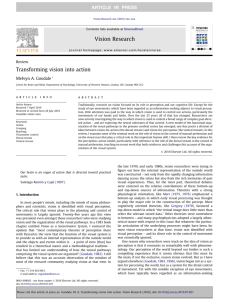to open or samples from three different family histories
advertisement
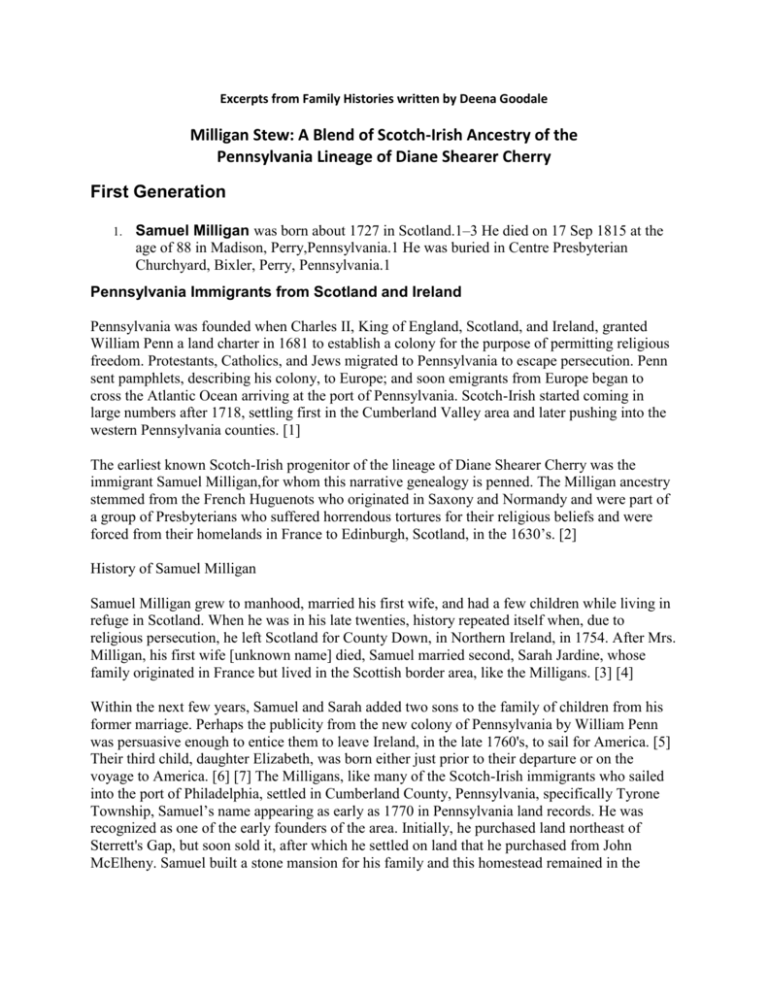
Excerpts from Family Histories written by Deena Goodale Milligan Stew: A Blend of Scotch-Irish Ancestry of the Pennsylvania Lineage of Diane Shearer Cherry First Generation 1. Samuel Milligan was born about 1727 in Scotland.1–3 He died on 17 Sep 1815 at the age of 88 in Madison, Perry,Pennsylvania.1 He was buried in Centre Presbyterian Churchyard, Bixler, Perry, Pennsylvania.1 Pennsylvania Immigrants from Scotland and Ireland Pennsylvania was founded when Charles II, King of England, Scotland, and Ireland, granted William Penn a land charter in 1681 to establish a colony for the purpose of permitting religious freedom. Protestants, Catholics, and Jews migrated to Pennsylvania to escape persecution. Penn sent pamphlets, describing his colony, to Europe; and soon emigrants from Europe began to cross the Atlantic Ocean arriving at the port of Pennsylvania. Scotch-Irish started coming in large numbers after 1718, settling first in the Cumberland Valley area and later pushing into the western Pennsylvania counties. [1] The earliest known Scotch-Irish progenitor of the lineage of Diane Shearer Cherry was the immigrant Samuel Milligan,for whom this narrative genealogy is penned. The Milligan ancestry stemmed from the French Huguenots who originated in Saxony and Normandy and were part of a group of Presbyterians who suffered horrendous tortures for their religious beliefs and were forced from their homelands in France to Edinburgh, Scotland, in the 1630’s. [2] History of Samuel Milligan Samuel Milligan grew to manhood, married his first wife, and had a few children while living in refuge in Scotland. When he was in his late twenties, history repeated itself when, due to religious persecution, he left Scotland for County Down, in Northern Ireland, in 1754. After Mrs. Milligan, his first wife [unknown name] died, Samuel married second, Sarah Jardine, whose family originated in France but lived in the Scottish border area, like the Milligans. [3] [4] Within the next few years, Samuel and Sarah added two sons to the family of children from his former marriage. Perhaps the publicity from the new colony of Pennsylvania by William Penn was persuasive enough to entice them to leave Ireland, in the late 1760's, to sail for America. [5] Their third child, daughter Elizabeth, was born either just prior to their departure or on the voyage to America. [6] [7] The Milligans, like many of the Scotch-Irish immigrants who sailed into the port of Philadelphia, settled in Cumberland County, Pennsylvania, specifically Tyrone Township, Samuel’s name appearing as early as 1770 in Pennsylvania land records. He was recognized as one of the early founders of the area. Initially, he purchased land northeast of Sterrett's Gap, but soon sold it, after which he settled on land that he purchased from John McElheny. Samuel built a stone mansion for his family and this homestead remained in the Milligan family for over one hundred years. It was nestled under the Counogocheague Mountain near the Susquehanna River which provided water for farming. Most likely, Samuel would have grown wheat and corn, the typical crops grown in this area during the colonial period. Samuel and Sarah raised their large family of children on what was called the Sandy Hill farm [8]. (This area later became Saville Township in Perry County, formed from Tyrone while Perry County was formed from Cumberland in 1820.) Because Pennsylvania offered religious freedom, the family lived peaceably practicing Presbyterianism, attending the Centre Church, formed in 1766 shortly before their arrival. It was near the vicinity of the church where many family members were eventually buried. [9] Arriving a few years prior to the war for independence, the Milligans lived only one hundred miles from Philadelphia, the instrumental meeting place for the founding fathers. In fact, the infamous Molly Pitcher, who carried water to the thirsty soldiers at the Battle of Monmouth, came from Cumberland County. In addition, three companies were organized from Tyrone Township to fight in the war. From one-third to one-half of men of Irish descent were participants in the war; and, no doubt, the Milligans would have been involved in the war's activities as well as taking part in the development of the new nation. Samuel was described as, “. . . a godly man, a staunch Presbyterian in faith, who trained his family to follow in his footsteps as far as he walked in the ways of righteousness; and so far as we know, his children were moral, industrious and useful citizens. They were nearly all communicants of the Presbyterian Church.” [10] Samuel lived shortly after the end of a second war, the War of 1812. Patriarch of the Milligans of Cumberland County, he died, leaving a will and mentioning each of his children by name as well as most of their spouses. [11] Wife Sarah died a few years later. A DIFFERENT PATH: THE STORY OF THE FAMILY OF JOSEPH DWIGHT GOODALE, A LYMAN WIGHT COLONIST CHAPTER 1 JOSEPH DWIGHT GOODALE Introduction A Goodale forefather, Robert Goodale, English Puritan and eighth great grandfather of the main character of this chapter, Joseph Dwight Goodale, was one of the first settlers in the Massachusetts colony in the early part of the seventeenth century. He, like other early settlers, had sailed to the New World to seek religious freedom. One hundred and forty years later, Joseph’s grandfather, Isaac Goodale, served in the war of the Revolution to fight for independence and to preserve not only religious freedom but other freedoms as well. Half a century following the war, Joseph was born into the new and independent nation of the United State of America, during the era of the Second Great Awakening.1 This era, with its resulting religious revivalism, had a profound effect upon the paths in life that Joseph and his brother Isaac chose to follow. 1 Joyce B. Maw, “Isaac Newton Goodale Life History,” Unpublished manuscript, 1. Early Years Electa Allen Goodale, Mother Isaac Goodale, older brother Native New Yorker Joseph Dwight Goodale was the fifth of eight children born to Isaac and Electa Allen Goodale, born on October 8, 1819, in Berkshire, New York. The family of Isaac and Electa Allen Goodale are: Elijah Allen Goodale born 20 Sep 1813 in Berkshire, Tioga, New York Isaac Newton Goodale born 6 Feb 1815 in Berkshire, Tioga, New York Warner Wright Goodale born 23 Aug 1816 in Berkshire, Tioga, New York Jemima Goodale born 11 Jul 1818 in Berkshire, Tioga, New York Joseph Dwight Goodale born 8 Oct 1891 in Berkshire, Tioga, New York Eathan Goodale born 12 Jun 1822 in Berkshire, Tioga, New York Electa Goodale born 26 Apr 1824 in Berkshire, Tioga, New York Sophia Goodale born 8 May 1825 in Berkshire, Tioga, New York2 3 4 5 Eleven years previous to Joseph’s birth, in 1808, Joseph’s grandfather, Revolutionary war veteran Isaac Goodale, migrated from Massachusetts, where generations of Goodales had lived, and became one of the first settlers in the newly established town of Berkshire. Primarily an agricultural town, it was situated in the Appalachian mountain range near a tributary of the great Susquehanna River; and, because of its rolling hills and resemblance to Berkshire County in Massachusetts, the geographical origin of many of the newcomers, the settlers adopted the name of Berkshire.6 It was here, in this picturesque farming town, where Joseph spent his youth. Joseph was about ten months old when he was enumerated in the 1820 Berkshire census with his parents, three brothers, and older sister. During the following decade, his three younger siblings were born, including infant brother Eathan who lived for only four days. Early in life, the boys, Elijah, Isaac, Warner, and Joseph worked outdoors under the direction of their father learning both the pioneering skills of timbering, using the lumber to provide for their shelter, and the agricultural skills of farming, using the harvest to provide for their food. These skills helped prepare them, a few years later, for their move to the Michigan wilderness where those skills would be utilized again. 2 Isaac Goodale Family Bible, Online, <www.rootsweb.ancestry.com> Joseph Dwight Goodale Entry. 3 George E. Williams, A Genealogy of the Descendants of Robert Goodale/ Goodell of Salem,Massachusetts (West Hartford, Connecticut: George E. Williams, 1984), 46. 4 Helena M. Hargrave, Goodale - Goodell Forbears (Madison, Wisconsin: University of Wisconsin, 1971), 20. 5 Williams, Descendants of Robert Goodale, 46. 6 Leroy W. Kingman, Editor, History of Berkshire, NY: From our County and Its People: A Memorial History of Tioga County, New York (Elmira, New York: W.A. Ferguson & Co., 1890), 1. Michigan Migration “Michigan Fever” during the 1830’s was stimulated by the completion of the Erie Canal, removal of Native Americans, and extensive government land surveying. Many New York immigrants moved to the Northwest Territory of Michigan including the family of Isaac and Electa Goodale who arrived in Wayne County, in May of 1830. At the time, it was one of the most populous counties in Michigan, located about sixteen miles from Detroit. In July 1832 Isaac purchased land in Section 21 in Wayne but lived there for only a few years, later choosing, in April of 1837, to establish a farm in Section 29 in the newly platted village of Lapeer, in Lapeer County. This is the county where Isaac and Electa, and all but two of their children chose to live for the remainder of their lives. The two who left Lapeer County and the state of Michigan were Isaac and Joseph.7 By 1840 the Goodale household numbered eight, oldest brother Elijah having located in the neighboring village of Mayfield. Again like other pioneer families, they earned their living clearing the ground for farming. By cutting down trees, the boys mastering this skill in their teenage years which proved to be a valuable one for both Joseph and Isaac who later worked in a lumber camp. Father Isaac had the help of his three adult sons, Isaac, Warner, and Joseph, to till the land on his farm, while Mother Electa had three daughters, Jemima, Electa, and Sophia, to help with other farm and household chores. Joseph passed through his teen years and grew to adulthood in the rural village of LaPeer during the era of the Second Great Awakening. AN IRISH FAMILY IN AMERICA: THE THOMAS HENRY AND ISABELLA SAWHILL NILSON FAMILY John Nilson John, the oldest child of Thomas and Isabella and my great, great grandfather, was born May 3, 1832, a few miles from Pittsburgh, in the Monongahela Valley, Pennsylvania.8 As a very young child, he lived for a short time in Indiana; and, before he turned four, a move was made to Guernsey County, Ohio, not too far from his Pennsylvania place of birth. During this time, John had a common school education.9 When he came of age, John, along with a young man by the name of John Miller, was learning the trade of harness maker and saddler under the guidance of Mr. John Beaton, and was living in his home in Union, Muskingum County, Ohio, by the time he had turned eighteen.10 Muskingum County neighbored Guernsey County where he had grown up, so he was not too far from his family. For the next four years, John continued with the apprenticeship; and, by age twenty-two, he had moved to Jeffersonville, Clark County, Indiana and then to Jackson County, Indiana.11 On September 9, 1858, in Medora, Carr Township, Jackson County, Indiana, John married Charity Hunsaker. 12 13 A few years later, after the Civil War had begun, John, Charity, and their son were living in Weddelville, Carr Township, Jackson County, where he had established his own saddle and U.S. General Land Office Records, 1796-1907. Online, <www.ancestry.com> Jasper County, Missouri, Missouri Birth and Death Records, p. 1, John Nilson, 22 October 1921; digital image, Missouri Digital Heritage (http://www.sos.mo.gov : accessed 26 May 2013). 9 Barneck, Hearts of the Children, p. 110. 7 8 10 1850 U.S. Census, Muskingum County, Ohio, population schedule, Union, p.449A, dwelling 1328,family 1321, John.Nelson; digital image, Ancestry.com (http://www.ancestry.com: accessed 26 May 2013); citing NARA microfilm publication M432, roll 718. 11 Barneck, Hearts of the Children, p. 106. 12 Ibid., p. 107. 13 Indiana Marriages, 1811-1959, digital image, FamilySearch.org (http://www.familysearch.org: accessed 26 May 2013). harness making business. By that time, he had been in the business for twelve years. In August of 1861, John left his business and family to enlist in the 25th Regiment of the Indiana Volunteer Infantry and fought in the civil war for the next four years.14 15 During the war years, John not only kept a soldier’s journal, but he frequently wrote to family during this time. Valuable information from both of these sources gives one a glimpse into his personality. Following the war, John returned to home and family in Indiana and lived there for a few more years. In 1868, he left for Missouri and then returned in 1869 to pack up his family for a move there to become a farmer.16 By 1870 John and his family were settled in Jasper County, in the township of Center Creek. 17 At this time, John became a farmer –later specializing in the dairy business--which he pursued for the rest of his life until he retired from farming around 1909, when his farm was sold.18 After its sale, John and Charity moved to a home on Lillie Street in Carl Junction, Jackson County, Missouri.19 He died in that home of sarcoma of the face on October 22, 1921, at the age of eighty-nine years.20 14 Sawhill, Sawhill Family, p. 78 U.S. Civil War Soldiers, 1861-1865, database, Ancestry.com (http://www.ancestry.com: accessed 26 May 2013). 16 Barneck, Hearts of the Children, p. 107. 17 1870 U.S. Census, Jasper County, Missouri, population schedule, Center Creek Township, p. 8B, dwelling 112, family 118, John Nelson; digital image, Ancestry.com (http://www.ancestry.com: accessed 26 May 2013); citing NARA microfilm publication M593, roll 783 . 18 Sawhill, Sawhill Family, p. 78 19 1900 U.S. Census, Jasper County, Missouri, population schedule, Twin Groves Ward 2, enumeration district (E.D.) 0083, p. 10B, dwelling 219, family 219, John Nilson, digital image, Ancestry.com (http://www.ancestry.com: accessed 26 May 2013); citing NARA microfilm publication T624, roll 792. 20 Jasper County, Missouri, Missouri Birth and Death Records, p. 1, John Nilson, 22 October 1921; digital image, Missouri Digital Heritage (http://www.sos.mo.gov : accessed 26 May 2013). 15
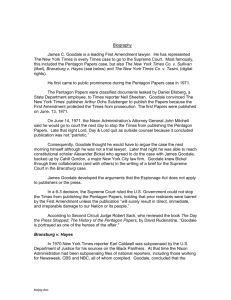
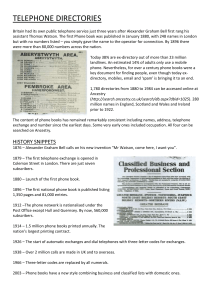
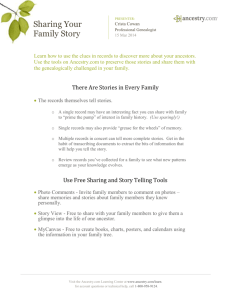
![Title of the Presentation Line 1 [36pt Calibri bold blue] Title of the](http://s2.studylib.net/store/data/005409852_1-2c69abc1cad256ea71f53622460b4508-300x300.png)
![[Enter name and address of recipient]](http://s3.studylib.net/store/data/006894526_1-40cade4c2feeab730a294e789abd2107-300x300.png)



